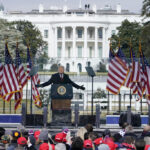
COLOMBO, Sri Lanka (AP) — Protesters retreated from government buildings Thursday in Sri Lanka, restoring a tenuous calm to the economically crippled country, and the embattled president at last emailed the resignation that demonstrators have sought for months.
President Gotabaya Rajapaksa fled a day earlier under pressure from the protesters enraged by the island nation’s economic collapse. He finally emailed his resignation a day later than promised, according to an official. But the crisis was far from over because he has further angered the crowds by making his prime minister the acting leader.
Protesters have pressed for both men to leave and for a unity government to address the economic calamity that has triggered widespread shortages of food, fuel and other necessities. With a fractured opposition and confusion over who was in charge, a solution seemed no closer following Rajapaksa’s departure.
The tentative way the resignation unfolded only added to turmoil. On Thursday, Indunil Yapa, an aide to Sri Lanka’s Parliament speaker, said Rajapaksa had emailed his resignation. The aide said a formal announcement would come after the authenticity and legality of the email is checked.
After word of the resignation spread, groups of people gathered near the presidential office to celebrate. Some cheered and danced, waving the national flag, as two men sang in Sinhalese on a small stage.
The protesters accuse Rajapaksa and his powerful political family of siphoning money from government coffers for years and his administration of hastening the country’s collapse by mismanaging the economy. The family has denied the corruption allegations, but Rajapaksa acknowledged that some of his policies contributed to the meltdown.
Months of protests reached a frenzied peak over the weekend when demonstrators stormed the president’s home and office and the official residence of Prime Minister Ranil Wickremesinghe. On Wednesday, they seized Wickremesinghe’s office.
Images of protesters inside the buildings — lounging on elegant sofas and beds, posing at officials’ desks and touring the opulent settings — have captured the world’s attention.
They initially vowed to hold those places until a new government was in place, but the movement shifted tactics Thursday, apparently concerned that any escalation in violence could undermine their message following clashes the previous night outside the Parliament that left dozens injured.
“The fear was that there could be a crack in the trust they held for the struggle,” said Nuzly, a protest leader who goes by only one name. “We’ve shown what power of the people can do, but it doesn’t mean we have to occupy these places.”
Devinda Kodagode, another protest leader, told The Associated Press they planned to vacate official buildings after Parliament speaker Mahinda Yapa Abeywardena said he was exploring legal options for the country in the wake of Rajapaksa’s departure.
Protesters withdrew from the prime minister’s residence and the president’s, where some moved a red carpet they had rolled up back into place. Others held a news conference to announce they were also pulling out of the prime minister’s office.
Visaka Jayaweer, a performing artist, described the bittersweet moment of closing the gate to the presidential palace after the crowds cleared out.
“Taking over his residence was a great moment. It showed just how much we wanted him to step down. But it is also a great relief” to leave, she said. “We were worried if people would act out — many were angry to see the luxury he had been living in when they were outside, struggling to buy milk for their children.”
The country remains a powder keg, and the military warned Thursday that it had powers to respond in case of chaos — a message some found concerning.
Troops in green uniforms and camouflage vests arrived in armored vehicles to reinforce barricades around the Parliament, while protesters vowed they would continue to rally outside the president’s office until a new government was in place.
The government announced another curfew in the capital Colombo and its suburbs until early Friday. It’s unclear what effect a curfew would have: Some ignored a previous one, but many others rarely leave their homes anyway because of fuel shortages.
Rajapaksa and his wife fled Sri Lanka early Wednesday for the Maldives, slipping away in the night aboard an air force plane. On Thursday, he went to Singapore, according to the city-state’s Foreign Ministry. It said he had not requested asylum.
Since Sri Lankan presidents are protected from arrest while in power it’s likely Rajapaksa wanted to plan his departure while he still had constitutional immunity and access to a military plane.
The political impasse threatens to worsen the bankrupt nation’s economic collapse since the absence of an alternative government could delay a hoped-for bailout from the International Monetary Fund. In the meantime, the country is relying on aid from India and China.
The shortages of basic necessities have sown despair among Sri Lanka’s 22 million people. The country’s rapid decline was all the more shocking because, before the recent crisis, the economy had been expanding, with a growing, comfortable middle class.
It was not immediately clear if Singapore would be Rajapaksa’s final destination, but he has previously sought medical care there, including undergoing heart surgery.
Sri Lankan lawmakers have agreed to elect a new president from their ranks on July 20 who will serve the remainder of Rajapaksa’s term, which ends in 2024. That person could potentially appoint a new prime minister, who would then have to be approved by Parliament.
___
The story has been updated to show that the Maldives official who said the president was headed to Saudi Arabia later said he could not confirm that.
___
Associated Press writer Bharatha Mallawarachi contributed to this report.
___
Find more of AP’s Sri Lanka coverage at https://apnews.com/hub/sri-lanka




